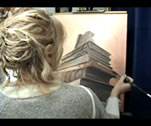This section provides a list of techniques, materials, and common references that are frequently used in the design and decorative painting profession.
this tree variety is sought after for its tight grain and its durability. It best serves floors, stair boards, sculpted woods and so forth. It is as sturdy as walnut, but more popular due to its more frequent occurrence in nature. Its grain pattern has a subtle and modest appearance; it can be faux finished with all of its wood details, or, offering a equally nice result, its tight grain can be replicated by flogging a wet glaze, bringing a more classically inspired modern rendition. It is still in fashion to ceruse oak: after a light staining of the oak, a white wash, a former ceruse white, is rubbed into the grain and soaked into the soft parts to leave the true color of the wood showing only through the hard fibers. The ceruse white mixed with an oil base is extremely resilient, hence its popularity. Such whitening process is now achieved with other whites, for ceruse comes from the highly toxic lead.
It is a glossy decorative stone with a pattern reminiscent of the malachite one, albeit it is not showing the typical circular designs of the latter. Depending on is origin, its appearance varies, showing a complex formation of angles and breccia, floating ribbons, with milky and slightly blurred colors of caramel, off white, yellow, grey and burgundy, for the most common specimen of the Algerian onyx. However it also comes in green, bluish grey and so on. Its most common destination is small boxes, tabletops, lamp bases, shower stalls, slabs, small columns, walls or door panels and so on. Because of the difficulty to simulate it, it is reserved for small surfaces.






